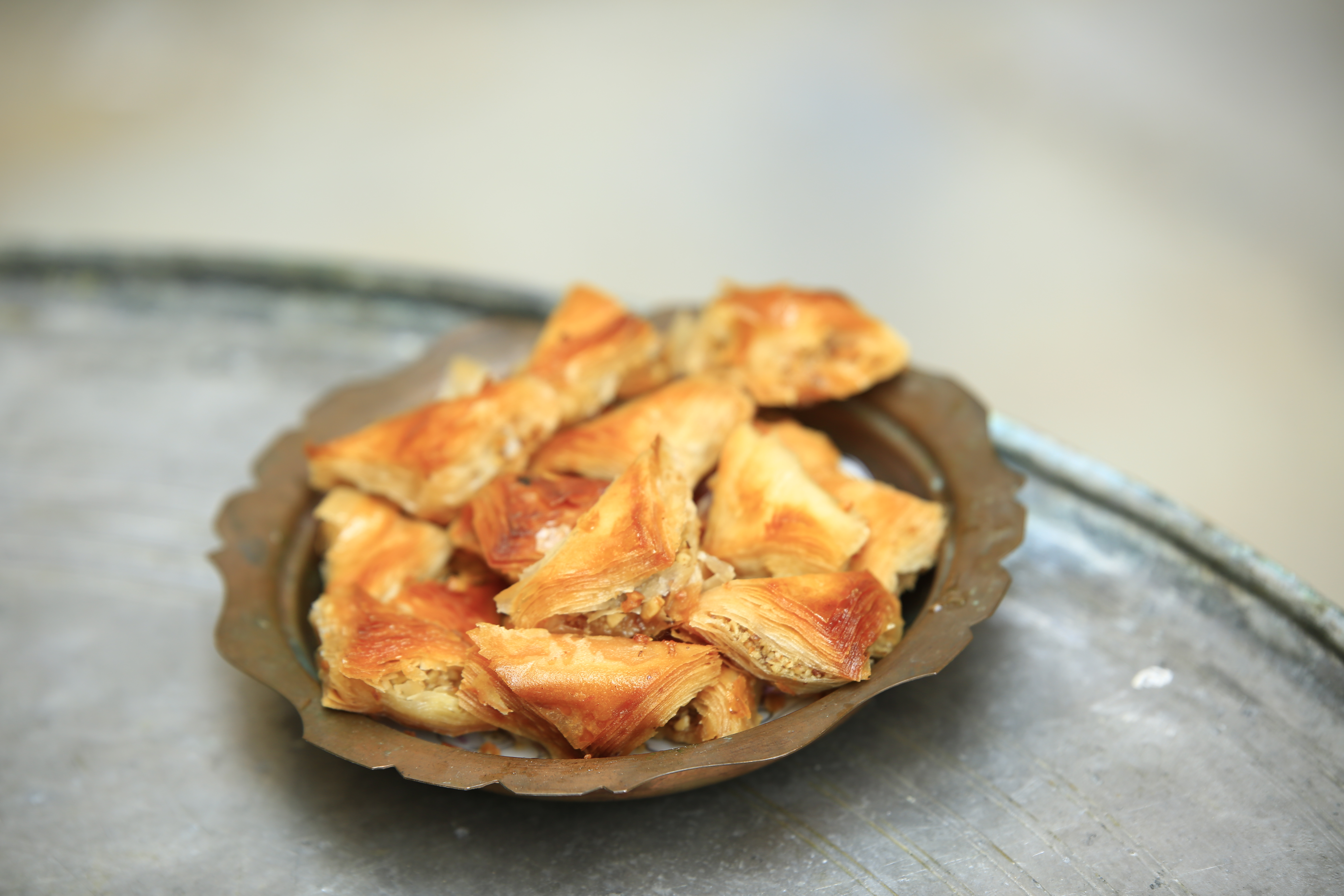Sivrihisar muska baklava is a traditional baklava variety unique to the Sivrihisar district of Eskişehir province, prepared by placing walnuts between very thinly rolled phyllo dough, folding it into a muska (triangle) shape, baking it, and then sweetening it with syrup.
Product Profile and Geographical Indication Type
Sivrihisar muska baklava is classified under the product group of bakery and pastry products, pastries, and desserts, specifically in the baklava category. It has been registered as a "designation of origin" by the Turkish Patent and Trademark Office.

Sivrihisar Muska Baklava (Turkish Patent and Trademark Office)
Product Description and Distinguishing Features
While Sivrihisar muska baklava shares similarities with other types of baklava in terms of content and preparation stages, it distinguishes itself by its shape (structure, form, appearance) and presentation. It has a recipe passed down through generations. It is made by placing walnuts between very thinly rolled phyllo dough, folding it into a muska shape, baking it, and then adding room-temperature syrup to the room-temperature baklava. It can be consumed with or without syrup.
Production Method
The necessary ingredients and production stages for Sivrihisar muska baklava are detailed below:
Ingredients:
- For the Dough: Soft-consistency dough made with special purpose pastry and phyllo flour (Ash content: maximum 0.65%, Protein: minimum 11%), olive oil, full-fat yogurt, egg, water, sugar (white sugar as defined in the TFC Sugar Communiqué), and salt.
- For Rolling the Dough: Special purpose pastry and phyllo flour (Ash content: maximum 0.65%, Protein: minimum 11%).
- Filling (Walnut): Thin-shelled walnuts.
- For Greasing Before Baking: Butter.
- For the Syrup: Sugar, water, and lemon.
Dough Preparation:
- A soft dough is prepared using special purpose pastry and phyllo flour. During preparation, sifted flour (250 gr + 100 gr), 3 medium-sized eggs (53-62 gr), olive oil (85 gr), yogurt (100 gr), water (100 gr), and salt (10 gr) are added and mixed. The dough is prepared to be soft and not sticky. All dough ingredients except for 100 grams of flour are mixed at once. Once the mixture becomes homogeneous, the remaining 100 grams of flour are added gradually to ensure the dough does not stick to the hands.
- The prepared dough is immediately divided into 10 balls (80-90 gr each), dusted with flour, placed on a tray, covered with a cheesecloth, and left to rest in a cool environment (15 °C) for 8 hours.
- The rested dough balls are individually rolled out with a rolling pin into circles 90 cm wide and 0.05 mm thin, using an average of 500 grams of flour, to form phyllo sheets. Each rolled phyllo sheet is laid out separately, ensuring they do not overlap.
- After all phyllo sheets (10 pieces) are rolled, they are stacked, cut in half in a crescent shape, and stacked again to obtain a total of 20 layers of phyllo.
- The resulting 20-layered phyllo is cut into squares 4 cm wide. Walnut kernels are placed in the center of each cut square phyllo, which consists of 20 layers, and the phyllo is folded in half without pressing, forming an equilateral triangle.
- The muska-shaped walnut phyllo pieces are neatly arranged on a baking tray, with the long sides of the triangles (the folded back part) touching each other closely.
- After all phyllo pieces are arranged on the tray, hot melted butter is drizzled over each piece.
- The buttered muska-shaped phyllo pieces are baked in a preheated 175°C oven for 30 minutes and then left to cool at room temperature.
- Room-temperature syrup is poured over the baked baklava, which is also at room temperature.
Walnut (Filling): 150 grams of thin-shelled walnuts are chopped with a knife, not too finely. The walnut content in the finished baklava should be at least 15%.
Fat (For Baking): 500 grams of butter are boiled.
Syrup: 540 grams of water and 680 grams of sugar are boiled. In the last five minutes of approximately 30 minutes of boiling, 5 grams of lemon juice are added to complete the syrup preparation, and it is left to cool at room temperature.
Registration Process and Details
An application for geographical indication registration of Sivrihisar muska baklava was made by Sivrihisar Municipality. The application was filed on April 12, 2017, with registration number C2017/022. Following the evaluation process, the product was officially registered as a "designation of origin" on September 5, 2018, with registration number 381. The address of the registrant is recorded as Cumhuriyet Mahallesi, Süleyman Demirel Caddesi No:1 Sivrihisar / Eskişehir.


